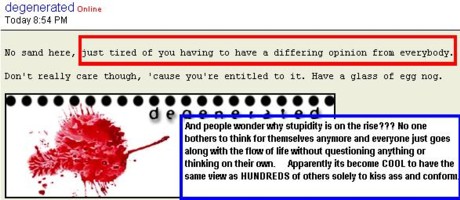I have the Eibach front and rear sway bar kit and i have to say even on stock suspension parts the ride is much improved. one thing i can not figure out...is how does the rear sway bar actually do anything seeing how it isnt actually attached to any frame/body points and how would it function seeing how we have a solid beam axle rear end? I know it works and there is a HUGE difference in handleing but i'm finding it hard to explain to my friends that it isnt a big red piece of useless metal. Any ideas?
http://auto.howstuffworks.com/question432.htm
Stabilizer bars are part of a car's suspension system. They are sometimes also called anti-sway bars or anti-roll bars. Their purpose in life is to try to keep the car's body from "rolling" in a sharp turn.
Think about what happens to a car in a sharp turn. If you are inside the car, you know that your body gets pulled toward the outside of the turn. The same thing is happening to all the parts of the car. So the part of the car on the outside of the turn gets pushed down toward the road and the part of the car on the inside of the turn rises up. In other words, the body of the car "rolls" 10 or 20 or 30 degrees toward the outside of the turn. If you take a turn fast enough, the tires on the inside of the turn actually rise off the road and the car flips over.
Roll is bad. It tends to put more weight on the outside tires and less weigh on the inside tires, reducing traction. It also messes up steering. What you would like is for the body of the car to remain flat through a turn so that the weight stays distributed evenly on all four tires.
A stabilizer bar tries to keep the car's body flat by moving force from one side of the body to another. To picture how a stabilizer bar works, imagine a metal rod that is an inch or two (2 to 5 cm) in diameter. If your front tires are 5 feet (1.6 meters) apart, make the rod about 4 feet long. Attach the rod to the frame of the car in front of the front tires, but attach it with bushings in such a way that it can rotate. Now attach arms from the rod to the front suspension member on both sides.
When you go into a turn now, the front suspension member of the outside of the turn gets pushed upward. The arm of the sway bar gets pushed upward, and this applies torsion to the rod. The torsion them moves the arm at the other end of the rod, and this causes the suspension on the other side of the car to compress as well. The car's body tends to stay flat in the turn.
If you don't have a stabilizer bar, you tend to have a lot of trouble with body roll in a turn. If you have too much stabilizer bar, you tend to lose independence between the suspension members on both sides of the car. When one wheel hits a bump, the stabilizer bar transmits the bump to the other side of the car as well, which is not what you want. The ideal is to find a setting that reduces body roll but does not hurt the independence of the tires.
<a href="http://www.lenkorules.com/"><img src="http://s93165229.onlinehome.us/images/misc/redsig.jpg"></a>
Ok. thanks for that info and i do understand that much. but how does that apply to a rear suspension that only travels up and down as a whole? and how does that work seeing how the rear bar does not attach to the frame/body at all? It only seems that the bar is only doing what the rest of the rear suspension is doing. Just going up and down as a whole unit. I would not have any questions about this if the bar attached to the body/frame and the rear suspension was independent Vs. Beam axle
in the rear the suspension beam twists....the swaybar mounted to the center helps limit the twist...
we have a semi-independant rear.
so we can have one side go up while having the other side stay down....

What Event said. GM calls it a Torsion Axle, which means it does twist. If you put a jack under one tire you'll see how it lefts off the ground long before the other (G-AMs are more obvious cause their heavier).


